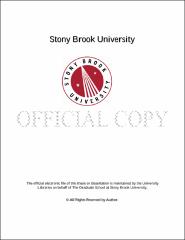| dc.identifier.uri | http://hdl.handle.net/11401/77632 | |
| dc.description.sponsorship | This work is sponsored by the Stony Brook University Graduate School in compliance with the requirements for completion of degree. | en_US |
| dc.format | Monograph | |
| dc.format.medium | Electronic Resource | en_US |
| dc.language.iso | en_US | |
| dc.publisher | The Graduate School, Stony Brook University: Stony Brook, NY. | |
| dc.type | Dissertation | |
| dcterms.abstract | By the Riemann-mapping theorem, one can always bijectively map an n-polygon P to another n-polygon Q conformally; in fact, any two simply connected domains can be conformally mapped to each other. However, this mapping need not necessarily map the vertices of P to the vertices of Q. In this case, one wants to find the best mapping between these polygons, i.e., one that minimizes the maximum angle distortion over all points in the base polygon, and maps the vertices of P to the vertices of Q. Such maps are called Teichmuller maps or extremal quasiconformal maps. In the first part of this work we present a variational approach in the continuous setting; we use the Hamilton-Krushkal, Reich-Strebel, necessary and sufficient condition for optimality to get an iterative method that successively improves the maximum distortion of the starting map. This procedure is proven to converge to the unique extremal quasiconformal or Teichm" {u}ller map. We then provide a numerical method for computing such maps by using this continuous construction and employing methods from convex optimization. Our method works not only for the polygon problem mentioned above, but also for the general extremal problem on punctured spheres. In the second part of this work we present some of the ways in which we use conformal geometry to help resolve some real-world problems encountered in the field of Wireless Sensor Networks (WSNs). We 1) use Mobius transformations to navigate through the path-space of a sensor network, 2) use harmonic measure to analyze the traffic pattern resulting from random routing, and 3) use the relation between Teichmuller theory and billiards to get dense curves in WSNs which are useful for many applications like serial data fusion, motion planning for data mules and node indexing. | |
| dcterms.available | 2017-09-20T16:53:07Z | |
| dcterms.contributor | Mitchell, Joseph S.B. | en_US |
| dcterms.contributor | Bender, Michael | en_US |
| dcterms.contributor | Gu, Xianfeng | en_US |
| dcterms.contributor | Mitchell, Joseph | en_US |
| dcterms.contributor | Gao, Jie | en_US |
| dcterms.contributor | Jiao, Xiangmin | en_US |
| dcterms.contributor | Gu, Xianfeng. | en_US |
| dcterms.creator | Goswami, Mayank | |
| dcterms.dateAccepted | 2017-09-20T16:53:07Z | |
| dcterms.dateSubmitted | 2017-09-20T16:53:07Z | |
| dcterms.description | Department of Applied Mathematics and Statistics. | en_US |
| dcterms.extent | 154 pg. | en_US |
| dcterms.format | Monograph | |
| dcterms.format | Application/PDF | en_US |
| dcterms.identifier | http://hdl.handle.net/11401/77632 | |
| dcterms.issued | 2015-08-01 | |
| dcterms.language | en_US | |
| dcterms.provenance | Made available in DSpace on 2017-09-20T16:53:07Z (GMT). No. of bitstreams: 1
Goswami_grad.sunysb_0771E_11483.pdf: 8592417 bytes, checksum: 7bbd9ba54bd86e0e01464fd796908eb5 (MD5)
Previous issue date: 2013 | en |
| dcterms.publisher | The Graduate School, Stony Brook University: Stony Brook, NY. | |
| dcterms.subject | Applied mathematics | |
| dcterms.subject | Algorithm, computer graphics, Conformal geometry, Quasiconformal, Sensor, Teichmuller | |
| dcterms.title | Computing Teichmuller Maps and Applications of Conformal Geometry to Sensor Networks | |
| dcterms.type | Dissertation | |

